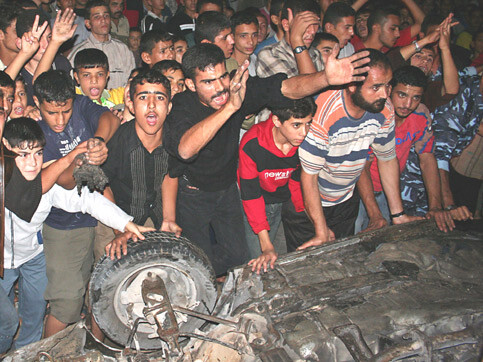Palestinian Center for Human Rights 28 October 2005

Palestinians search the wreck of Islamic Jihad leader Shadi Mhanna after an Israeli missile hit it and killed 7 persons in the Jabalya refugee camp in northern Gaza October 28, 2005. (Photo: MAANnews/Wesam Saleh)
At least 1.5 million Palestinians in the Gaza Strip have been living in an atmosphere of war in the past 24 hours imposed by an escalation of attacks by Israeli Occupation Forces (IOF). In the context of this escalation, IOF committed another extra-judicial assassination in the northern Gaza Strip, which left dead 7 Palestinians (two members of the Islamic Jihad and 5 civilian bystanders, including 3 children). In addition, 19 civilians were injured. This latest attack came in the context of another wave of escalation by IOF, which has included also launching air attacks and mock air raids using F-16 fighter jets.
This attack and subsequent attacks have followed a statement by the Israeli Prime Minister Ariel Sharon that he gave the Israeli military a green line to launch a wide scale operation, which would be unlimited in time, against what he called “Palestinian Terrorism,” and a focused offensive, including extra-judicial assassinations, against the Islamic Jihad, whose military wing claimed responsibility for the bombing in the Israeli town of Hadera on Wednesday, 26 October 2005, which left 5 Israelis dead and injured dozens of others.
According to investigations conducted by PCHR, at approximately 19:50 on Thursday, 27 October 2005, an Israeli drone that were flying over the northern Gaza Strip launched a missile at a civilian car, a white Subaru, which was traveling on al-Turk road towards Jabalya refugee camp. Four Palestinians were traveling in the car. The missile hit the car directly and destroyed it. The four passengers were instantly killed. Three civilian bystanders, all of them were children, were also killed. In addition, 19 civilian bystanders, including 7 children, were injured; the injuries of 3 of them were described by medical sources as serious.
The passengers in the car were later identified as two members of the Islamic Jihad and two civilians who got into the car a few minutes before the attack as the driver offered to transport them to Jablaya refugee camp, where all of the passengers lived.
The passengers were identified as: Shadi Suhail Muhanna, 26, a member of the al-Quds Brigades, the military wing of the Islamic Jihad, who was the main target by this attack as IOF claimed; Nafez Mohammed Abu Hassanain, 31, a member of the al-Quds Brigades; Mohammed Rumaih al-Wehaidi, 55; and Fayez Hassan Badran, 52.
The three children who were killed in the street were identified as: Rami Riad ‘Assaf, 17; Karam Mohammed Abu Naji, 14; and Saleh Suleiman Abu Naji, 15.
PCHR’s investigations refute the IOF’s claim that the high number of casualties is attributed to explosives that were being transported by the car, which caused several explosions as soon as the car was attacked. According to eyewitnesses, only one explosion was heard, which was resulted by the missile launched by the Israeli drone. The missile hit the center of the car and shrapnel from it spread into the street which was over-crowded. This attack further proves IOF’s disregard for the lives of Palestinian civilians.
Three hours following this attacks, Israeli F-16 fighter jets launched 6 missiles in 3 hours at uninhabited areas to cut dirt roads in the northern Gaza Strip (to the east of the Industrial Zone in Beit Hanoun; near al-Shuhada cemetery in the east of Jabalya refugee camp; and to the north of Beit Lahia). No casualties were reported, but the electricity network of the northern Gaza Strip was damaged.
Between 12:00 and 14:00 on Friday, 28 October 2005, Israeli war planes launched 5 missiles at uninhabited areas to the east of Beit Hanoun and to the north of Beit Lahia.
For the 5th consecutive day, Israeli warplanes have continued to carry out mock air raids throughout the Gaza Strip, especially at night. Israeli warplanes have broken the sound barrier causing heavy blasts, which have threatened the safety and security of Palestinian civilians and deprived them of sleeping. These mock raids have also caused panic among civilians, especially children and women, and damaged houses and civilian facilities.
While it strongly condemns this latest extra-judicial assassination and subsequent attacks by IOF,
PCHR points out that this latest wave of escalation, which have included actions and reactions, came as a consequence of an extra-judicial killing committed by IOF in Tulkarm on 23 October 2005, which left two Palestinians, including a the leader of the military wing of the Islamic Jihad in the West Bank, dead.
PCHR believes that this serious escalation in attacks by IOF proves that IOF continue to occupy the Gaza Strip, despite the recent evacuation of Israeli settlements in the context of the “Disengagement Plan.” PCHR reiterates its position declared on 13 October 2004 that IOF have not ended their occupation of the Gaza Strip rather they have redeployed around it, while the occupation has remained effective in its legal and materialistic forms.
PCHR points out that 14 Palestinians, including 6 children, have been killed by IOF since the implementation of the “Disengagement Plan” on 12 September 2005. PCHR is gravely concerned that military operations, which the Israeli government decided, may cause more casualties among Palestinian civilians and damage their property.
PCHR calls upon the international community to assume its responsibilities, and calls upon the High Contracting Parties to the Fourth Geneva Convention in particular to fulfill their obligations to ensure protection for Palestinian civilians in the Occupied Palestinian Territory and to stop attacks launched by IOF.
Related Links